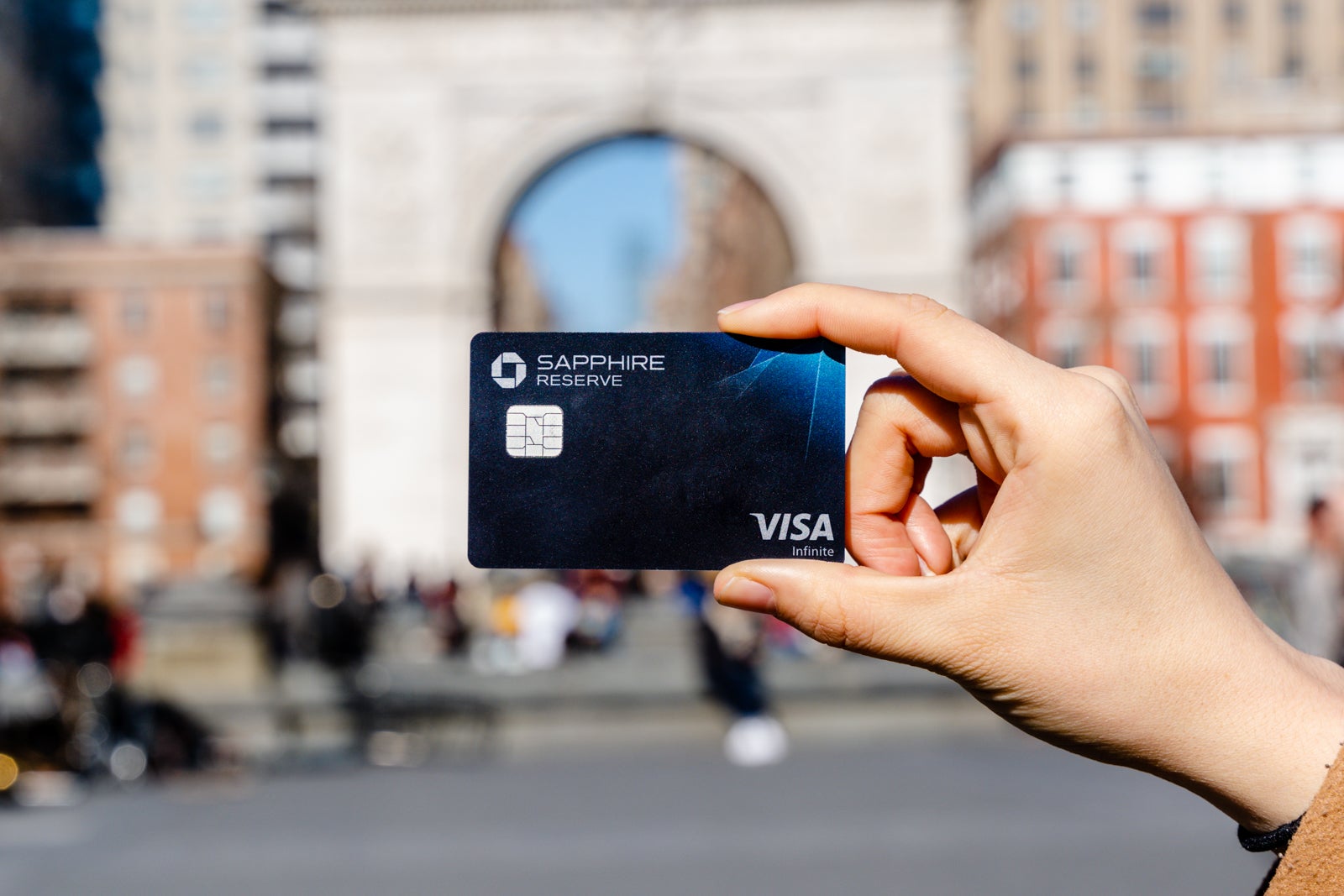Editor’s note: This is a recurring post, regularly updated with new information and offers.
The Chase Sapphire Reserve and the Chase Sapphire Preferred Card are two of the most talked-about travel credit cards on the market, thanks to the valuable Ultimate Rewards program, top-notch benefits and great travel protections. But which one is the best match for you?
You might assume that the Chase Sapphire Reserve — with a higher annual fee and more luxury benefits — is always the better choice. It is the higher-tier card, but that may not necessarily mean it’s the best card for you. Depending on your spending habits, travel goals and existing credit card lineup, the Sapphire Preferred could be the more attractive option for your wallet.
Currently, the Sapphire Reserve has a sign-up bonus of 60,000 bonus points after you spend $4,000 on purchases in the first three months from account opening. The Sapphire Preferred, on the other hand, currently has an elevated offer of 80,000 bonus points after you spend $4,000 on purchases in the first three months from account opening.
We’ll compare the two cards below to help you make the best decision.
Before we get into the benefits of these two cards, note that you can’t hold both the Sapphire Preferred and the Sapphire Reserve simultaneously. You must also wait at least 48 months after earning the sign-up bonus on one card before earning it on the other. That’s why making an informed decision from the start is so important.
Also, ensure you don’t bump up against Chase’s infamous 5/24 rule to maximize your chances of approval.
Sapphire Preferred vs. Sapphire Reserve overview
Card |
Chase Sapphire Preferred |
Chase Sapphire Reserve |
| Annual fee | $95. | $550. |
| Earning rates | 5 points per dollar on travel purchased through the Ultimate Rewards portal.
5 points per dollar on Lyft. 5 points per dollar on Peloton equipment and accessory purchases of $250 or more with a max earn of 25,000 total points through March 2025. 3 points per dollar on dining at restaurants worldwide, online grocery purchases and select streaming services. 2 points per dollar on all other travel. 1 point per dollar on everything else. |
10 points per dollar on hotels, car rentals and Chase Dining purchased through the Ultimate Rewards portal.
10 points per dollar on Lyft. 10 points per dollar on Peloton equipment and accessory purchases of $250 or more with a max earn of 50,000 total points through March 2025. 5 points per dollar on flights purchased through the Ultimate Rewards portal. 3 points per dollar on dining and all other travel. 1 point per dollar on everything else. |
| Sign-up bonus | 80,000 bonus points after you spend $4,000 on purchases in the first three months from account opening. | 60,000 bonus points after you spend $4,000 on purchases in the first three months from account opening. |
| Value for Ultimate Rewards travel redemptions | 1.25 cents. | 1.5 cents. |
| Built-in credits | $50 annual ultimate rewards hotel credit.
10% anniversary points boost. |
$300 annual travel credit.
Global Entry/TSA PreCheck application fee credit (up to $100). |
| Lounge access | None. | Priority Pass Select. |
| Authorized user fee | $0. | $75 for each user per year. |
Related: Read TPG’s reviews of the Chase Sapphire Preferred and Chase Sapphire Reserve
Travel coverage and purchase protection
It’s also worth comparing the coverage these two cards offer for things such as travel delays, trip cancellation and purchase protection. Although they offer some identical benefits, there are a few differences:
Card |
Chase Sapphire Preferred |
Chase Sapphire Reserve |
| Rental car insurance | Primary; covers up to actual cash value of most rentals (excluding “high value” and “exotic” cars). | Primary; covers up to $75,000 for theft and collision. |
| Roadside assistance | $79.95 per service call. | Up to $50 per incident, up to four times a year. |
| Trip cancellation insurance | Up to $10,000 per covered trip. | Up to $10,000 per covered trip. |
| Trip delay insurance | Up to $500 per ticket for delays of 12 or more hours (or requiring an overnight stay). | Up to $500 per ticket for delays of six or more hours (or requiring an overnight stay). |
| Baggage delay insurance | Up to $100 per day for up to five days. | Up to $100 per day for up to five days. |
| Lost luggage reimbursement | Up to $3,000 per person (up to $500 per person for jewelry, watches, cameras, video recorders and other electronic equipment). | Up to $3,000 per person (up to $500 per person for jewelry, watches, cameras, video recorders and other electronic equipment). |
| Emergency medical and dental |
None. | Up to $2,500 if you get sick or injured on a covered trip (subject to a $50 deductible). |
| Travel accident insurance | $500,000 for common carrier loss of life benefit. | $1,000,000 for common carrier loss of life benefit. |
| Purchase protection | Up to $500 per claim and up to $50,000 per year. | Up to $10,000 per claim and up to $50,000 per year. |
As you can see, both cards offer extensive coverage when you travel and shop — though the Sapphire Reserve can offer slightly better benefits on select policies.
Read more: Your guide to Chase’s trip insurance coverage
The argument for the Sapphire Reserve
The Chase Sapphire Reserve is the more premium of the two cards. If you’re a frequent traveler or big spender, the Reserve will likely give you more value over time.

Here are some reasons why the Sapphire Reserve makes sense over the Preferred:
Premium travel benefits
If you’re looking for premium perks, the Reserve has them.
You’ll get a $300 travel credit each year with the Sapphire Reserve, an up to $100 credit for the TSA PreCheck or Global Entry application fee every four years and a Priority Pass Select membership that gives you entry into more than 1,300 airport lounges around the world.
Plus, while both cards offer complimentary DashPass with food delivery service DoorDash (valid through Dec. 31, 2024), Sapphire Reserve cardholders can access $5 in monthly credit for in-app orders through December 2024.
If you can take full advantage of many of those perks and credits, you’ll more than offset the cost of the Sapphire Reserve’s $550 annual fee.
Higher earning rates
The Chase Sapphire Reserve has a higher earning rate than the Chase Sapphire Preferred in select categories:
- Hotels and car rentals through Ultimate Rewards Travel: 10 points per dollar (compared to 5 points per dollar on the Sapphire Preferred).
- Lyft rides (through March 2025): 10 points per dollar (5 points per dollar on the CSP).
- Dining through Ultimate Rewards: 10 points per dollar (3 points per dollar on CSP).
- All other travel: 3 points per dollar (2 points per dollar on CSP).
The more you plan to spend in those bonus categories, the bigger the difference in rewards.
Related: How to earn 10 points per dollar on select dining reservations and takeout with Chase Sapphire
50% redemption bonus
In addition to a higher earning rate, the Sapphire Reserve also has a higher redemption rate when you book travel through the Chase Ultimate Rewards portal. The Chase Sapphire Reserve allows you to redeem each point at 1.5 cents each toward travel, compared to 1.25 cents each with the Preferred. If you only transfer points to hotel and airline partners, this difference won’t matter, but it plays into the equation if you use points via the Chase travel site.
We don’t typically suggest booking hotels through a third-party portal such as this one unless you find a great deal or want to stay at a boutique place that doesn’t have a loyalty program, because you typically won’t earn hotel points, elite credits or have your elite status recognized.
But if you are regularly booking airfare through the Chase portal, it could be worth having the Reserve for the higher redemption rate.
For example, a $600 plane ticket will cost you 48,000 points with the Sapphire Preferred but only 40,000 points with the Sapphire Reserve.
Purchases can also be erased at a higher rate through Chase’s Pay Yourself Back feature. Right now, this option provides a value of 1 cent per point on gas and grocery purchases with the Sapphire Preferred but 1.25 cents per point on those same purchases with the Sapphire Reserve (both through June 30, 2023).
Related: How I scored a new Away bag for 16,000 Ultimate Rewards points
Better trip insurance coverage
Many travel credit cards have cut trip insurance over the last few years, so premium coverage is harder to come by. Both the Sapphire Preferred and the Reserve offer a great selection of travel insurance benefits, but you get better coverage with the Sapphire Reserve. This takes a few forms:
- Higher coverage amounts (e.g., travel accident insurance and purchase protection).
- Quicker protection (e.g., trip delay coverage, which requires just a six-hour delay on the Reserve but a 12-hour delay on the Preferred).
- Additional benefits (e.g., emergency medical and dental coverage is offered on the Reserve but not on the Preferred).
On its own, this enhanced protection may not be a reason to choose the Sapphire Reserve over the Preferred. However, when combined with the other additional benefits the Reserve version offers, it could be a deciding factor.
Related: The best credit cards for travel insurance
The argument for the Sapphire Preferred
The Chase Sapphire Preferred can’t compete with the Reserve when it comes to perks such as the annual travel credit and lounge access, but this card still could make more sense to you with its (much) lower annual fee.

Lower annual fee
One key advantage to the Chase Sapphire Preferred is the significantly lower annual fee. The Sapphire Reserve costs $550 yearly, while the Preferred costs only $95. Of course, it’s worth keeping in mind that the Sapphire Reserve offers a $300 annual travel credit, which effectively lowers the cost to just $250 per year — a $155 premium over the Sapphire Preferred.
If you’ll spend at least $300 on travel in a year anyway and know you’ll use the perks offered on the card, it could be worth paying more for the Reserve. But the Sapphire Preferred Card is a worthwhile alternative if that fee doesn’t seem manageable based on your travel and spending habits.
Same access to Ultimate Rewards transfer partners
Even though it doesn’t offer all the same premium benefits, the Sapphire Preferred offers identical transfer benefits to the Sapphire Reserve card.
No matter which card you choose, you’ll be able to move your Ultimate Rewards points (earned both through the sign-up bonus and through spending) to the program’s 11 airline and three hotel partners at a 1:1 ratio. This includes programs like United MileagePlus, World of Hyatt, Southwest Rapid Rewards and British Airways Executive Club. Chase’s airline partners give you access to all three top alliances (Oneworld, Star Alliance and SkyTeam), so you’ll have a strong variety of options for putting your points to use. And you’ll occasionally see transfer bonuses — and like the partners, these are identical across the two cards.
The two cards do, however, differ when it comes to redeeming points through the Chase Ultimate Rewards travel portal, as previously mentioned. With the Sapphire Preferred, you’ll get 1.25 cents in value per point, while with the Reserve you’ll get a higher value of 1.5 cents per point.
Related: Maximizing Chase’s transfer partners
You still get primary rental car insurance
Long before Chase introduced the Sapphire Reserve, award travelers sang the praises of the Sapphire Preferred card’s auto collision damage waiver (CDW) benefit. This perk provides reimbursement for damage as a result of collision or theft for rentals of 31 days or less when you decline the rental agency’s CDW. If you’re eligible, you’ll be reimbursed up to the actual cash value of most rental vehicles.
The policies differ slightly between the cards, as the Chase Sapphire Reserve caps reimbursement at $75,000, and the Sapphire Preferred’s coverage specifically excludes “high value” and “exotic” cars. However, it’s highly unlikely you’d come anywhere near that higher coverage amount, and most rentals aren’t classified as “high value” or “exotic” vehicles. As a result, there isn’t much of a practical difference between the two.
Related: The perfect rental car? My experience renting a Tesla Model 3 from Hertz

No authorized user fee
There are various reasons to consider an authorized user on your credit cards. You could be looking to help someone build up a credit history, you might want to provide employees with cards for a business account or maybe you’re looking to earn bonus rewards for adding additional users.
With the Sapphire Preferred, there’s no cost to add additional users. With the Sapphire Reserve card, on the other hand, it costs $75 per year for each authorized user (though this includes individual Priority Pass Select membership for airport lounge access).
Easier to get approved
A final reason to consider the Sapphire Preferred Card over the Sapphire Reserve Card is that it could be easier to be approved for the Preferred. As an ultra-premium card, the Reserve requires a top-notch credit score. You’ll still need a solid score for the Sapphire Preferred (at least in the high 600s), but you might have an easier time getting approved for that card if your score is on the lower end of the optimal range.
Related: What is a good credit score?
Bottom line
The Chase Sapphire Preferred has long been a TPG favorite. When the Sapphire Reserve launched, however, it quickly became a go-to for luxury perks such as a Priority Pass Select membership and the annual $300 travel credit. Ultimately, you really can’t go wrong with either card, as they both have a lot to offer both beginners and veterans in the points and miles game.
Related: The one credit card TPG staffers can’t live without
Apply for the Chase Sapphire Preferred Card with an 80,000-point sign-up bonus or the Chase Sapphire Reserve with a 60,000-point sign-up bonus.
Additional reporting by Emily Thompson, Ryan Wilcox and Benét J. Wilson.



